The spectacular Cape Canaveral on the East Coast of Florida needs no introduction. From the place where men first shot for the moon to Disneyland just an hour away, it’s the perfect recipe for a family vacation. It’s also home to incredible angling opportunities, some of the best on the Space Coast, in fact. Deep sea fishing in Cape Canaveral is a must for any sport fishing enthusiast.
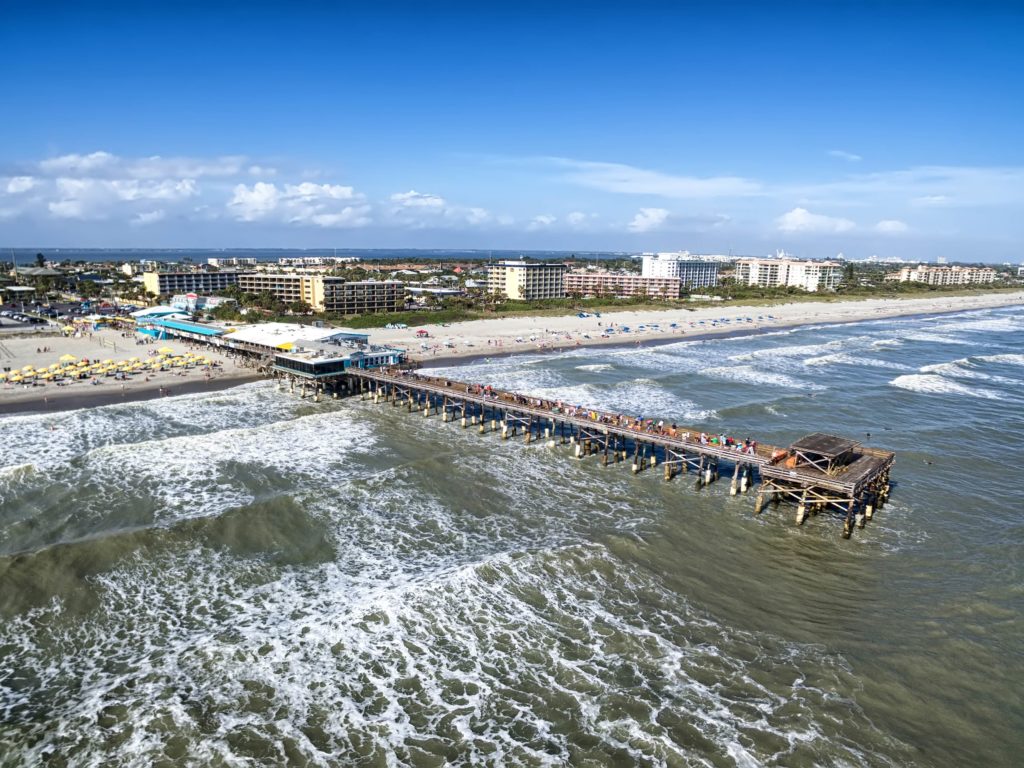
So why is deep sea fishing so popular here? Well, Cape Canaveral offers easy access to the Gulf Stream and the Atlantic Ocean. A steep oceanic shelf lies just several miles off the coast, rewarding anglers with a healthy dose of potential catches. In addition, the city’s home to the busiest port in the country, Port Canaveral. Many deep sea fishing charters launch from there, as it’s the closest getaway to the bluewater in the region.
In this guide, we’ll talk about what makes Cape Canaveral one of the greatest deep sea fishing destinations on the East Coast. So, without further ado…
What can I catch while deep sea fishing in Cape Canaveral?

Deep sea fishing and variety are practically synonymous in Cape Canaveral. Firstly, you don’t have to go too far offshore to find a great selection of targets. As soon as you leave the marina, you’ll be greeted by various bottom dwellers, such as Snapper and Grouper. Move to deeper waters, and you can add Tilefish and even bigger species to your list.
Snapper and Grouper aside, Cape Canaveral is also home to Tuna, Cobia, colorful Mahi Mahi, and even hard-fighting Billfish. In fact, if we were to compose a whole list of potential catches, this section would need at least five parts.
Below are our top picks for deep sea fishing catches in Cape Canaveral.
Mahi Mahi

Any angler knows that Mahi Mahi are some of the best gifts the ocean has to offer. These gorgeous creatures take their rightful place among the most popular game fish species along the Space Coast, if not the whole state.
Trolling is the most popular technique among Cape Canaveral anglers, paired with some local tips and tricks. You can target Mahi throughout the whole offshore waters, although some areas are more productive than others. Look for floating debris, schools of bait, temperature changes, weed lines, and rips.
The absolute peak months to catch Mahi Mahi in Cape Canaveral are May and October, although you can book a trip anytime from spring through fall. Many anglers keep their catch, sticking to the bag limit of 10 fish per person.
Tilefish

Golden and Blueline Tilefish are two other exciting deep sea fishing catches in Cape Canaveral. However, you’ll need to book a longer trip and get ready to run a deep drop rod to get Tilefish. As a true saltwater delicacy, these deep-water monsters are somewhat of a rarity compared to other Florida’s offshore species.
Not every single deep sea fishing captain targets Tilefish, though. You’ll need to use special equipment and fish in at least 600 feet of water. Tilefish prefer the soft, mud bottom with temperatures ranging from 47 to 53 degrees.
As for local regulations, you can keep three Blueline Tilefish whenever the season allows. Make sure to check the dates in advance. Note that there’s also a three-fish aggregate bag limit in the Atlantic state waters that includes Tilefish and Grouper.
If you’re after Golden Tilefish, there’s a more generous bag limit of eight fish per angler, per trip. That is, should you manage to catch so many!
Grouper

No top 10 Cape Canaveral deep sea fishing list is complete without Grouper. These beautiful fish are abundant here, and anglers can score quite a few types of Grouper if they know where to look. Cape Canaveral yields anything from Gag, Red, and Snowy to Scamp, Speckled Hind, and Warsaw Grouper.
Some of these species are heavily protected and regulated, so you’ll need to check when each species is in season. Daily bag limits also vary. For example, you can only keep one Warsaw or Speckled Hind Grouper per boat and one Gag or Snowy per person.
No matter which Grouper you’re after, get ready for a fight. As bottom feeders, these fish are typically caught by bottom fishing, and they usually try to hide in rocks and structure once they’ve been hooked. A lot of locals say that when fishing for Grouper, there’s only one winner – you or the fish!
Snappers
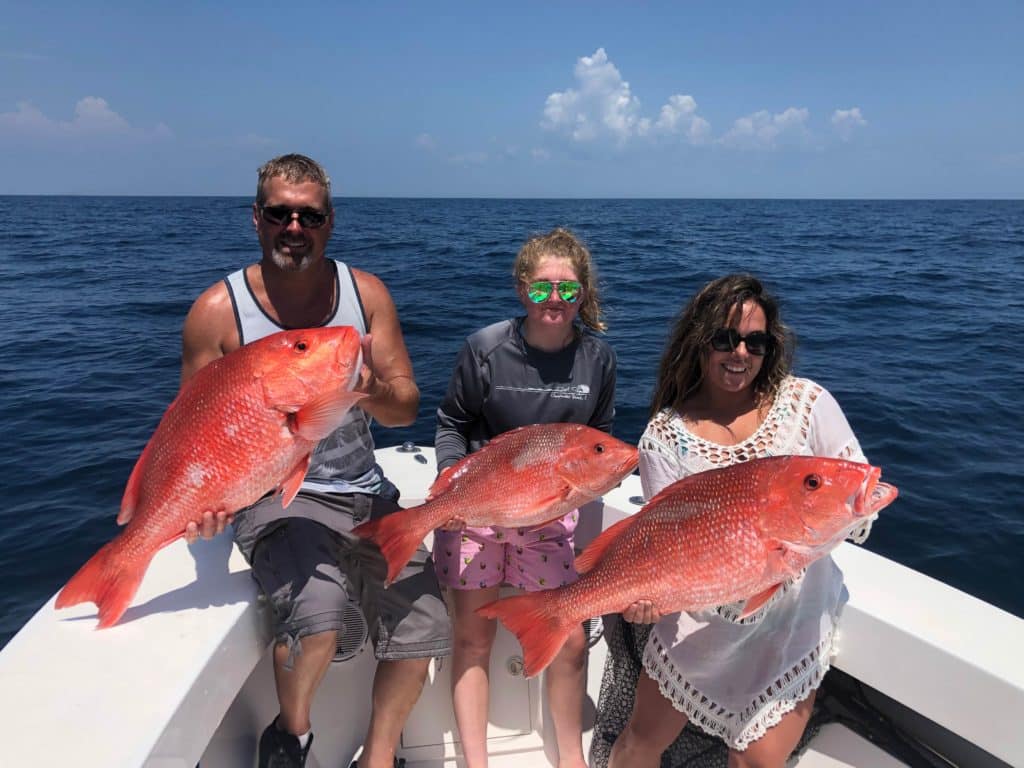
While some Snappers can be found throughout the nearshore waters, you can find them at many different depths. For a true deep sea fishing adventure, you’ll want to book a trip to Federal waters, although you can definitely troll for smaller Snapper on your way to the fishing grounds.
So, what’s on the Snapper fishing menu? Deep sea fishing in Cape Canaveral includes anything from Lane, Mutton, and Red to Mangrove and Yellowtail Snapper. The good news is that you can find some of the Snappers practically any time of the year, although some species have their own season. More on that below.
Similar to seasonality, Snapper regulations vary depending on the exact species. There’s a 10 Snapper aggregate bag limit, although Red Snapper doesn’t fall within it. There’s a separate bag limit for Reds of two fish per person per day. This means when fishing during the Red Snapper Federal season, you get to keep two Reds in addition to the aggregate limit. There’s also a specific bag limit for Mutton Snapper of five fish per angler within the aggregate.
Tuna

Synonymous with deep sea fishing, Tuna are widely available in Cape Canaveral’s Gulf Stream waters. And not just any Tuna: here, you can get your hands on both Yellowfin and Blackfin, if you know where to look.
In a lot of situations, finding the best spot for Tuna may require heading a bit further off the coast. However, some anglers come across smaller fish even while bottom fishing, although trolling is the technique of choice for Tuna anglers. Local captains prefer fishing around anchored Shrimp boats since it’s where Tuna are likely to patrol.
When it comes to bag limits, you can keep up to three Yellowfin Tuna with a size limit of 27 inches each and up to two Blackfin per person. There’s also the overall limit of 10 fish per boat.
Billfish
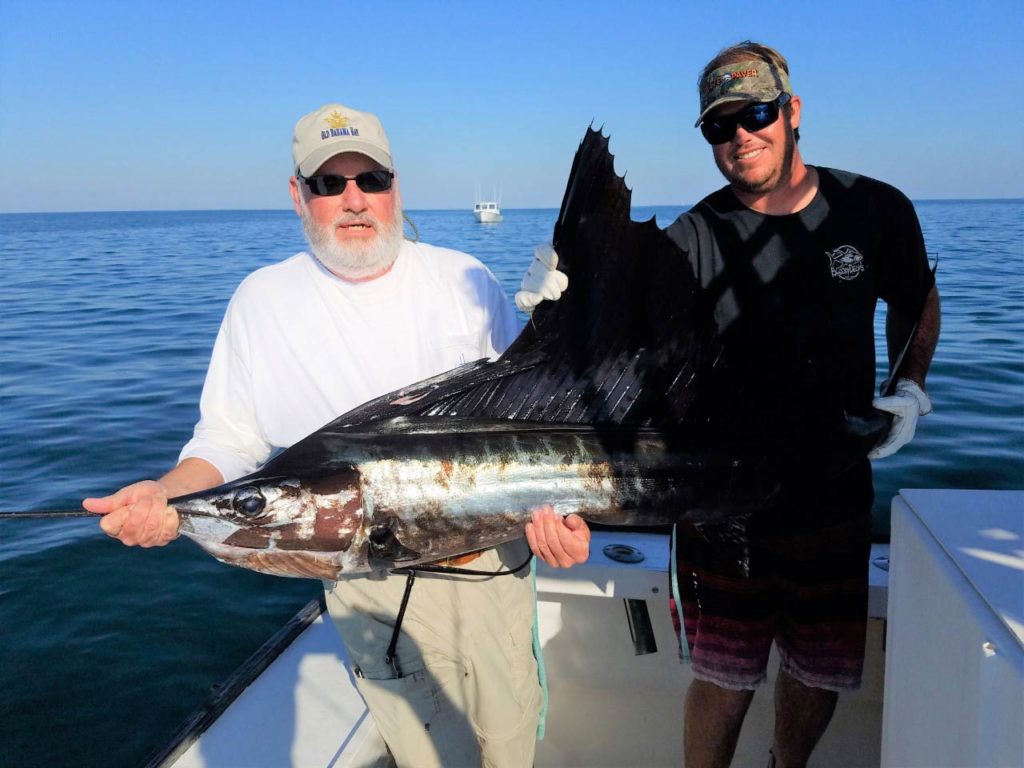
Last but not least, Cape Canaveral deep sea fishing anglers can target various types of Billfish. To get your hands on White and Blue Marlin, you’ll need to get ready for a longer ride. These fish hang out further into the Gulf Stream.
Sailfish, on the other hand, bite much closer to the shore. In fact, a lot of anglers target them within 20 miles of the coast, which can be done on a shorter trip. Indeed, you can get your hands on both Mahi Mahi and Sailfish on a 6-hour trolling trip!
Marlin and Sailfish aside, bigger depths mean bigger fish. If you take a trip all the way to the Continental Shelf, you’ll find yourself in a perfect spot for a deep-dropping action for Swordfish.
While there are bag limits for these Billfish species at one per person, it’s common to release the fish. When you’ve taken a picture with a freshly-caught Sailfish, Marlin, or Swordfish, your captain will help you release the catch back into the water alive and unharmed.
Where should I go deep sea fishing in Cape Canaveral?
Now that you know what to target, it’s time to talk about the best offshore fishing spots around. First of all, Cape Canaveral has over 120 square miles of wrecks, reefs, and natural hard bottom ridges. Then, if you head 30-40 miles off Port Canaveral, you’ll be able to fish the west wall of Florida’s Gulfstream. And that’s not to mention miles of productive feeding grounds towards the Continental Shelf!
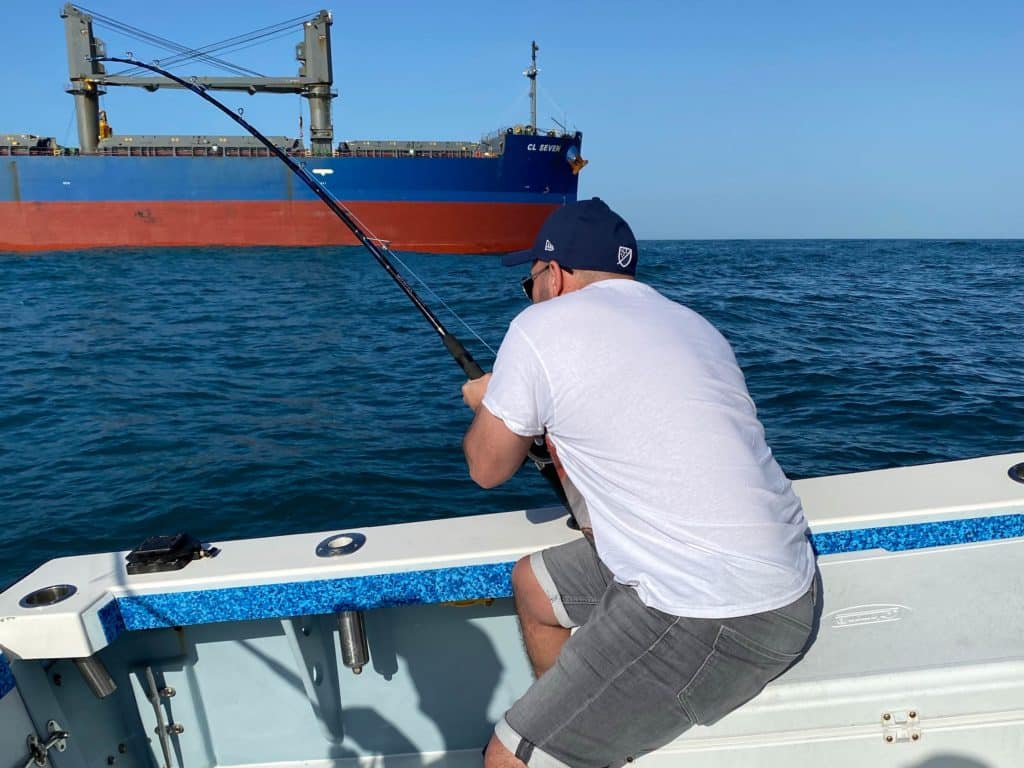
Here’s a quick list of deep sea fishing spots you might want to consider:
- 12 Fathom Ridge. This is the shallowest of the ridges in the area, but not any less productive. You can fish at depths of 72 feet, targeting a large variety of species that hang around corals and rocky bottoms.
- 21 Fathom Ridge. Unlike the 12 Fathom, this ridge is much deeper, yet less defined. It’s a perfect spot for a trolling excursion, with depths reaching 126 feet.
- 27 Fathom Ridge. As the farthest ridge from the port, this spot offers exciting fishing opportunities for an experienced angler. The water here is 162′ deep, but the currents can be pretty strong.
- Oculina Bank. The Oculina Bank is a 105-mile federally protected zone along the shelf edge, with depths over 300 feet. The only fishing activity that’s allowed here is trolling.
As we mentioned earlier, Port Canaveral is perhaps the most popular launching point for the majority of local deep sea fishing charters. However, the neighboring towns also offer great access to the bluewater. For instance, Sebastian and Daytona Beach are both within an hour’s drive from Port Canaveral, while Cocoa Beach and Merritt Island are practically within walking distance.
When should I go deep sea fishing in Cape Canaveral?

In general, there’s always something biting in Cape Canaveral. On the other hand, each season brings something different. Winter months are reserved for Sailfish, Blackfin Tuna, Mahi Mahi, and potential Kingfish and Barracuda on your way to the fishing grounds. Usually, the Golden Tilefish season opens in January, although you might want to be flexible with your dates in case the weather doesn’t cooperate.
The main action happens in spring. April, May, and June are the busiest months for local captains who offer deep sea fishing. Tuna usually peaks around the end of May and can sometimes bite well into summer. Snowy Grouper and Blueline Tilefish are also among potential spring catches.
The summer months are all about Swordfish in the calm offshore seas, although you can target them year-round. Marlin fishing is also hot in summer, although you can definitely target them in late spring.
Fall, on the other hand, might be somewhat of a slower period, though you can still fish for Wahoo and some Snapper. A good idea is to always check the open seasons of each fish species you intend to target.
How can I go deep sea fishing in Cape Canaveral?
The majority of offshore fishing in Cape Canaveral is done by either trolling or bottom fishing, or a combination of both. However, certain species can be caught by deep dropping or kite fishing. Let’s talk about the most common methods to catch whatever the deep sea holds, starting with trolling.
Trolling
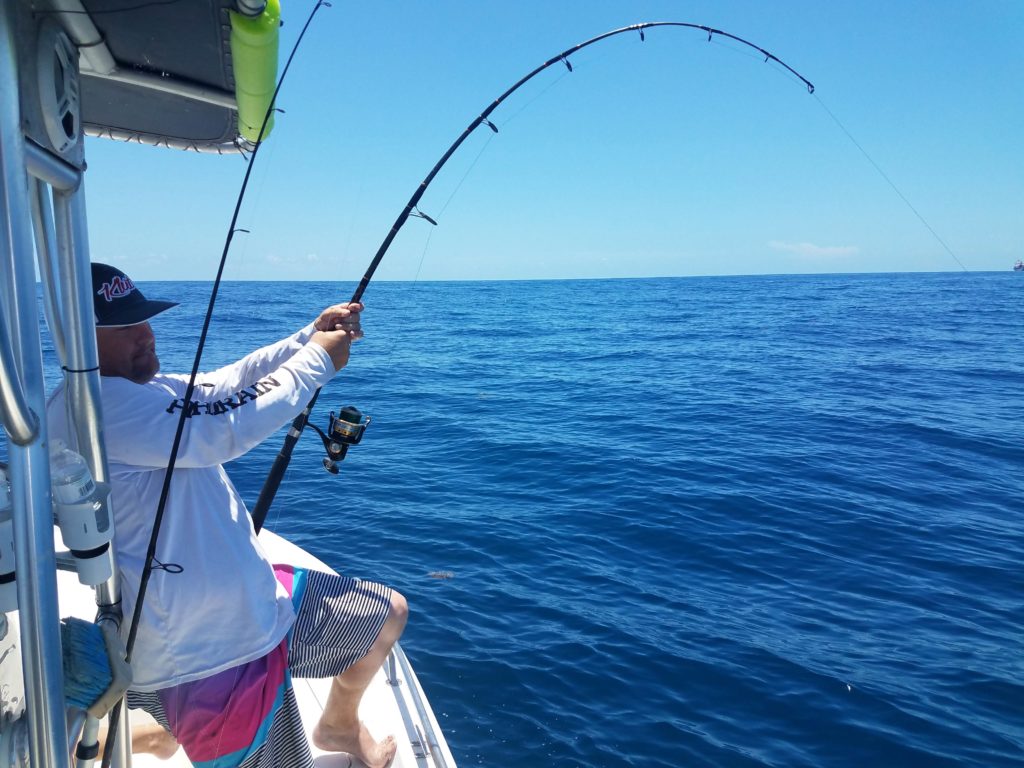
So, what do local captains do to make sure Tuna don’t ignore their trolled offerings? What does a typical trolling trip look like?
Species such as Mahi Mahi, Tuna, Wahoo, Marlin, and Sailfish are surface feeders. This means your aim is to present the right bait or lure to attract their attention. Your ultimate goal is to create an attractive scenario to bring the targeted fish up to eat.
In general, the majority of Cape Canaveral anglers are either live-baiters or dead-bait trollers. For instance, Mahi Mahi can be interested in trolling lures, artificials, or Ballyhoo, since they’re fast eaters. Your captain might try varying trolling speed between 2 and 9 knots until you get a bite, making sure you stay consistent. Tuna, on the other hand, may react better to heavy lures with several color combinations that you run deeper at slower speeds.
Overall, the best trolling setup depends on the species you’re after. If you’re not planning on concentrating on one single species, consider preparing different kinds of bait and lure ahead of time. Live bait is never a bad choice, along with cut bait and rubber skirts.
What gear do I need for trolling in Cape Canaveral?
Putting Tuna, Mahi Mahi, Billfish, or any other Cape Canaveral deep sea fishing target into the ice box requires the right equipment. Since you’re not going for the bay-sized catches, opt for conventional or spinning rods with gimbaled butts and either monofilament or braid line reels. The 20 lb class is a good starting point for Mahi Mahi, while anything larger, such as Billfish and Tuna, requires at least a 30 lb class.
Kite Fishing
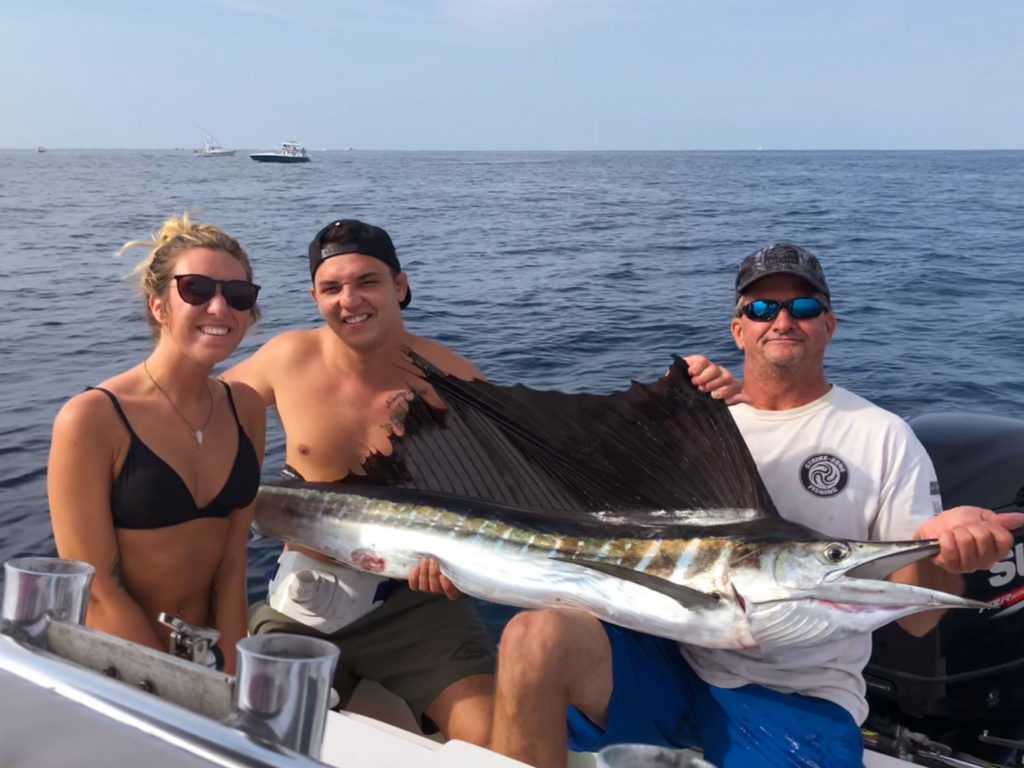
If you’re one of those anglers addicted to spectacular Sailfish strikes, booking a kite fishing trip is a must.
This technique involves suspending bait, such as goggle-eyes and cigar minnows, from release clips at various intervals on the boat up to the kite. It can be positioned to the side of the boat or right behind it, depending on your captain’s preference. Some anglers may even run two kites at a time, covering even more water.
Once the kite is settled with the wind, anglers keep the bait on the surface, waiting for a bite. If the wind doesn’t cooperate, you can use large helium balloons to make sure your kite stays aloft.
What gear do I need for kite fishing in Cape Canaveral?
Aside from the kite itself, locals normally use 20–25 lb rods with small conventional reels due to their line capacity. This setup is usually matched with a 20 lb high-visibility test line and a 15′ fluorocarbon leader.
Bottom Fishing

If Snapper, Grouper, Amberjack, and Cobia are your main priority, then you’ll want to consider booking a bottom fishing trip. This technique involves using heavy tackle to target various bottom dwellers on or near the ocean floor.
While this may sound simple, it’s not that easy. Taking to the reefs, wrecks, and ledges for Lane Snapper or Grouper requires a lot of local knowledge. The thing is, when working the bottom, you need to actually feel the bite all the way to the boat. That is if you manage to find the right spot to anchor up.
Local captains use a selection of bait and lure to attract bottom dwellers. Amberjack, for instance, like vertical jigs and heavy soft plastics, while Snappers can be lured in with fresh live bait and circle hooks. In general, you’ll want to tailor your bait, lure, and rigs to the conditions and species you’re after.
What gear do I need for bottom fishing in Cape Canaveral?
Just like with trolling and kite fishing, you’ll need to have the right gear to increase success around reefs, wrecks, and structure. A good recipe from local captains includes using enough rope for anchoring and long leaders on bottom rigs. Opt for a medium-heavy fast-action rod around 7′ long, paired with a matching reel.
Deep Dropping
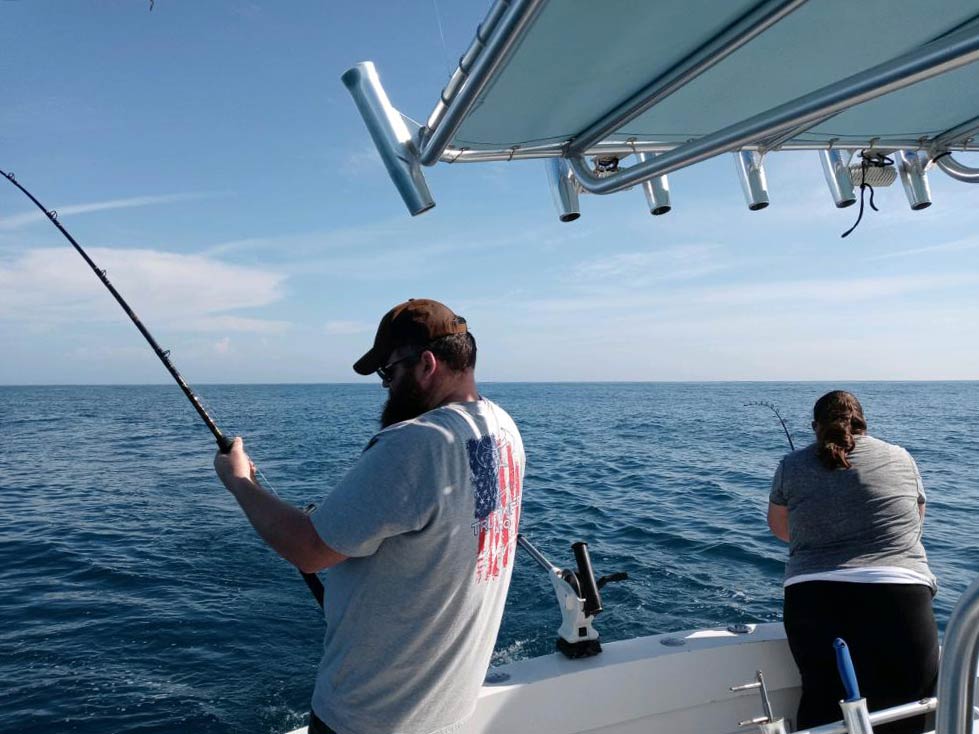
As we mentioned in the species section, deep dropping is the go-to technique for Tilefish. It usually involves heading to the edge of the Continental Shelf and dragging your bait along the bottom. It’s pretty similar to bottom fishing, although you’ll fish in up to 800 feet of water with electric reels. Naturally, this means heading 30+ miles offshore.
Your main target, Tilefish, dig their burrows in the mud bottom along the Shelf’s plateaus. The good news is that Tiles live in colonies; once you’ve located one, chances are you might find more. Sometimes, other species react to your presentation, which doesn’t always mean a bad thing.
While Tuna and Mahi can accidentally get hooked, they’re not the main deep dropping targets. Tilefish aside, you can also go for Amberjack, Yellowedge Grouper, and Snowy Grouper.
What gear do I need for deep dropping in Cape Canaveral?
First and foremost, the most essential gear is electric fishing reels and braid mainline. Some captains use lightweight but heavy-action reels with backup. 500 feet of stainless steel or soft wire fishing line in the 80-pound test class are common. There are also deep drop rigs called “meat curtains.”
Cape Canaveral Deep Sea Fishing F.A.Qs
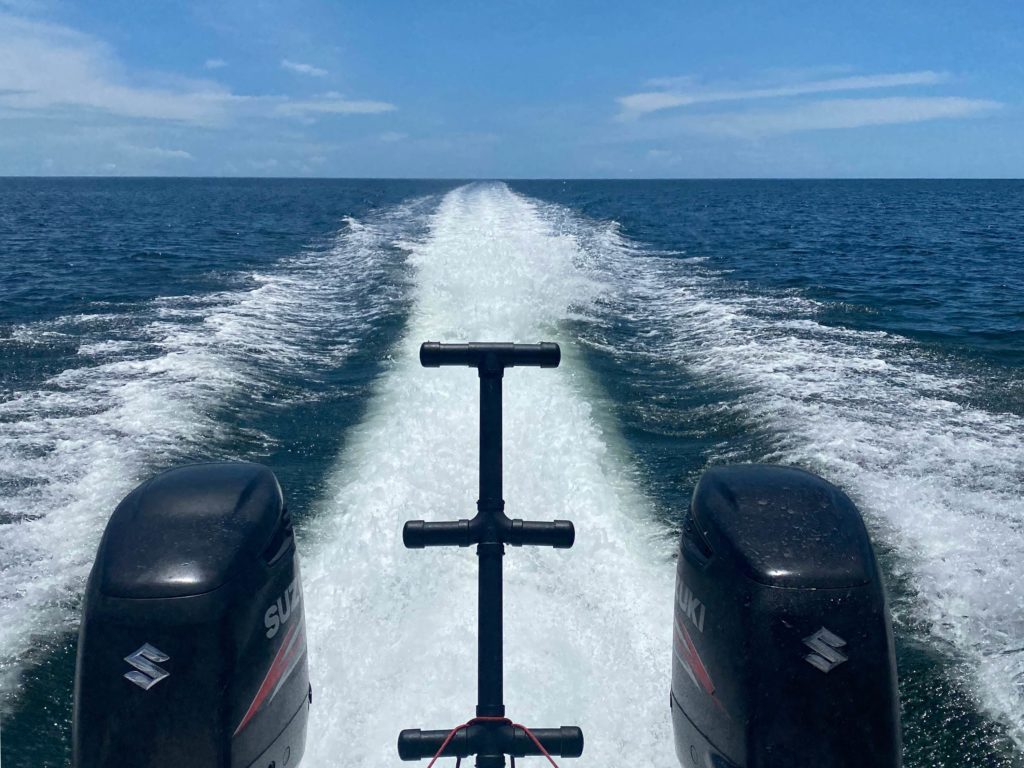
Do I need a fishing license to go deep sea fishing in Cape Canaveral?
- If you book a trip with a local charter, there’s nothing you need to worry about. All licensed saltwater charters cover fishing permits for everyone onboard.
Are there any deep sea fishing tournaments in Cape Canaveral?
- There are multiple deep sea and offshore events in Cape Canaveral that take place every year. You can take part in Dolphin Tournaments, Central Florida Shootout, and the Florida Sportfishing Association’s annual Offshore Slam to name a few.
Can kids go deep sea fishing in Cape Canaveral?
- Of course! There are, however, several factors you should consider. Make sure the weather conditions are right and book a trip with a children-friendly charter. As a parent, you can discuss how far offshore you and your kids are comfortable to go.
Deep Sea Fishing in Cape Canaveral – The Atlantic and Beyond
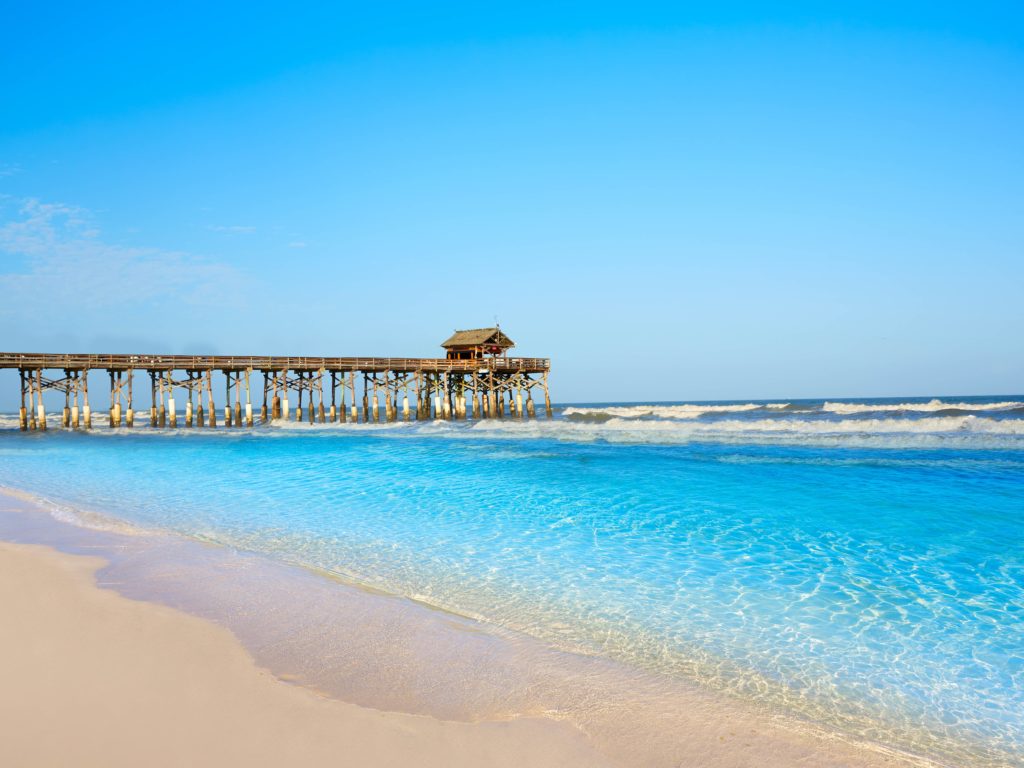
There’s no doubt that Cape Canaveral is one of the best deep sea fishing destinations on the Space Coast. It has the perfect recipe for a successful offshore adventure as well as a dash of adrenaline and an amazing list of potential catches. With deep sea fishing in Cape Canaveral, there’s always action in the waters. You only have to book a trip, hop on board, and head to the open seas!
Have you ever been deep sea fishing in Cape Canaveral? What’s your favorite technique? Any trophies to brag about? Let us know in the comments below!
The post Deep Sea Fishing in Cape Canaveral: The Complete Guide appeared first on FishingBooker Blog.
https://ift.tt/pxvSg3h
0 Comments
Enregistrer un commentaire